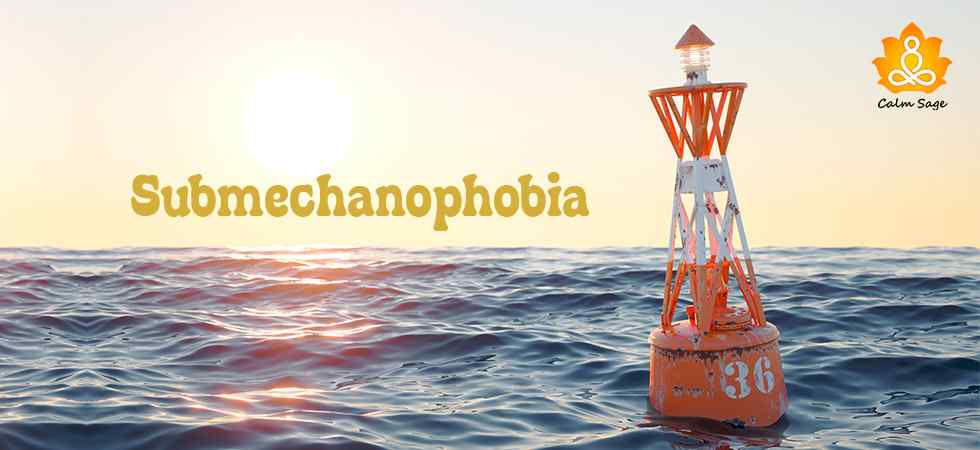Mini-Guide To Submechanophobia: The Fear Of Submerged Objects

Phobias are many, yet some fears sound unreal. Even though it has been confirmed as a real fear, submechanophobia might still feel a little irrational to many. However, for people who struggle with this fear, submechanophobia can be as real as any threat.
Submechanophobia or the fear of submerged objects is a rare yet specific phobia that can cause severe anxiety and overwhelming feelings that might affect your daily functioning.
Did you know that more than 12% of adults in the United States alone experience some or the other specific phobias such as automantonophobia, gamophobia, megalophobia, and others? And that women are more susceptible to phobias than men.
Even though the cases might not be many and the symptoms not that severe, submechanophobia can make you feel uncomfortable even at the thought of sunken ships, shipwrecks, or buoys. If it does make you feel anxious, then it’s recommended that you speak to a professional for a proper diagnosis and treatment.
In this article today, we’re exploring the symptoms of submechanophobia, the diagnosis criteria, what other phobias can be related to the fear of submerged objects, and how you can get the treatment.
Symptoms Of Submechanophobia, The Fear Of Submerged Objects

Just like any other specific phobia, the signs and symptoms of submechanophobia are straightforward. When you think about or see any submerged object such as a buoy or a ship, you may experience;
- Shortness of breath
- Sweating and trembling
- Anxious thoughts
- Intense feelings of fear
- Nausea
- Dizziness
- Difficulty focusing
The severity of these symptoms may vary depending on the proximity of your phobia. If you are only thinking about submerged objects or shipwrecks, then the severity of your symptoms would be mild but if you’re in the presence of man-made submerged objects, then you may experience these symptoms on a severe scale.
To be diagnosed with submechanophobia, you need to meet the diagnosis criteria set in the DSM-5. Let’s take a look at that.
Diagnosing Submechanophobia
Being fearful of a situation or an object is not wrong nor does it mean that you have a phobia. In the DSM-5, the criteria to diagnose a phobia are listed as such;
- Your fear should be unreasonable and persistent (or excessive)
- The response to the fear must be immediate and extreme (making it look like one’s in danger even if they aren’t)
- One must go beyond their limits to avoid their phobia or its circumstances. If that’s not the response, then they need to at least have symptoms of extreme distress (panic attacks, anxiety attacks, etc.)
- Their phobia must significantly impact their daily functioning including social life, professional life, academic performance, etc.
- The symptoms of the phobia must last longer than 6 months
- The symptoms of the phobia must not be related to other mental or physical health conditions
If you meet the above diagnosis criteria for specific phobias, only then you’ll be diagnosed and suggested a treatment plan.
On the topic of related mental health conditions, there are other specific fears that the fear of submerged objects can be linked with.
Other Phobias Related To Submechanophobia

-
Fear of the Unknown
The fear of the unknown is one fear that can be linked with submechanophobia. How? Well, many bodies of water carry hazardous substances, industrial waste, and other such substances. If you’re unfamiliar with a body of water such as a lake, river, or stream, then the thought of not knowing what’s in the water can trigger the phobia.
-
Fear of Animals
The fear of animals such as sharks or snakes can also trigger submechanophobia. If you have a fear of animals, then you may be afraid to go into certain bodies of water where you know sharks or water snakes exists.
-
Fear of Germs
The fear of germs or mysophobia is another fear that can be related to submechanophobia. Many water bodies contain toxins, bacteria, and parasites. If you’re scared of contamination, then you might avoid certain water bodies to prevent triggering the fear.
-
Fear of Ships
Many people are afraid of boats or other means of water transportation, but certain people have a fear of ships. I’m talking about multi-deck ships here! This could also be linked with the fear of large objects along with the fear of submerged objects. Submarines could also be one of the biggest triggers of submechanophobia.
-
Fear of the Ocean
In an ocean, you’re likely to see buoyant objects at almost every kilometer. So, the fear of submerged objects is likely connected to the fear of the ocean or thalassophobia. If you’re afraid of man-made submerged objects, then you’re also likely to avoid the ocean.
How Can Submechanophobia Be Treated?
If your symptoms of submechanophobia are affecting your daily functioning, then a professional therapist can help with the diagnosis and suggest a treatment plan to help cope with the fear. If your job does not require you to be on the water, then avoiding the trigger (in our case, water bodies), could help.
If your job does require you to be on the water, then talking to a professional could be viable as they can help you figure out the cause of your fear and how to work around it.
There are therapies such as cognitive behavioral therapy (CBT), exposure therapy, or VR therapy that can help you face your fear and change the way you look at your phobia. You can also, with the help of a therapist, work on changing your negative or fearful thoughts to positive ones that can help you function better.
Final Thoughts…
If your submechanophobia is affecting your life and if you find yourself canceling plans, events, or even jobs that you might enjoy because of your fear, then it’s recommended that you speak to a professional for further help and support.
The fear of submerged objects is not common, but it still exists and is valid. If your symptoms of submechanophobia are severe, then you can learn to reduce the intensity and severity of your fear with the help of a therapist.
Don’t let the fear of submerged objects affect your daily life too much. Reach out to a professional today.
I hope this article helped you understand what submechanophobia is, its symptoms, diagnosis, and treatment options available. For more, you can write to us at info@calmsage.com or DM us on social media. You can also share your thoughts in the comments below.
Take Care!




















